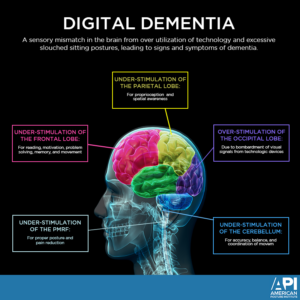What is Digital Dementia?
Digital Dementia is a sensory mismatch in the brain from over utilization of technology and excessive slouched sitting postures, leading to signs and symptoms of dementia. When children spend an excessive amount of time on their devices with poor posture a sensory dissociation occurs where the back of the brain is over active, but the frontal aspect of the brain is underactive.
The occipital lobe in the back of the spine processes visual signals such as visual cues from video game, social media, or TV programs. While seated and engaged with technology, the front part of the brain including the frontal and parietal lobes are under-stimulated. These regions of the brain are responsible for higher order thinking and good behaviors such as motivation, goal setting, reading, writing, memory, and socially appropriate behaviors. These areas of the brain are also responsible for movement and body position sense.
In addition to lack of stimulation of the front of the brain, the vestibular system and the cerebellum for better balance and coordination of movement are under stimulated. This can lead to uncoordinated movement patterns and poor posture long term.
Is my Kid at Risk for Developing Digital Dementia?
If your child spends more than a few hours each day on their devices while sitting with slumped posture, they may be at risk for developing Digital Dementia. Children who spend hours per day on social media are at risk for developing a “Fear of Missing Out” of FOMO. A desire to stay connected keeps adolescents attached to their devices. Research demonstrates a correlation of FOMO and Digital Dementia.
Children’s brains are particularly susceptible for the development of Digital Dementia if they excessively utilize technology during the developmental years. As children are developing they should spend a minimum of 2 hours per day outside playing to develop the writing within their brains that supports coordinated movement patterns, a sense of belonging, tactile stimulation for the development of their cortical maps, motivation, the execution of goal-oriented movements, and to offset the ill health effects of being sedentary.
Risk Factors of Digital Dementia
1. Does your child prefer to play with technology than to play outside?
2. Does your child have slouched or slumped posture?
3. Does your child spend hours per day attached to their device while seated?
What are The Signs and Symptoms of Digital Dementia
Has your child ever seemed secluded, depressed, disengaged or unmotivated? Or maybe you’ve noticed they walk with a closed posture and uncoordinated movement patterns? Do they forget common things and rely on their technology for directions, phone numbers and reminders?
If your child presents with the following signs and symptoms, then they are likely developing Digital Dementia.
1. Flexor dominant posture (forward head posture, rounded shoulders and a C-shaped curve.)
2. Developmental delays
3. Inability to remember number patterns or directions
4. Social seclusion
5. Lack of motivation
6. Anxiety and depression
7. Forgetfulness
8. Anger for no apparent reason
9. Uncoordinated movement patterns
What Should I Do
Have a Posture Examination performed. If your child presents with forward head posture, postural hyper kyphosis and or hip misalignments, then it needs to be corrected. When postural distortion patterns are left uncorrected it can cause chronic changes in body position that may predispose your child to pain and injuries and preventable health conditions.
It is important to consult a Posture Expert to have your child’s posture evaluated and corrected.
Consider the following tips for management and prevention of Digital Dementia.
1. Limit technology to a maximum of two hours per day
2. Get outside and play
3. Sit on an exercise ball during the day
4. Take posture breaks each hour
5. Utilise posture reminders for better posture habits
How is Blue Light from Devices Affecting my Child
Does your child report difficulty sleeping at night? If they do it may be due to over utilization of their technology devices at night. Screens emit blue light that is associated with alertness, increased cognition and increased heart rate. Although this is okay during the day, if children are attached to their devices at night it can disrupt their sleep-wake cycles.
Limiting screen time during the evenings will help your child have regular sleep patterns. When they are rested they can perform better in school and will be more motivated to engage in physical activity. Low levels of sleep can lower neural capacity.
What will Happen if I don’t Take Action
Children are more susceptible to Digital Dementia during developmental stages. Their brains are more plastic, and their bodies are developing. With poor cognitive stimulation and poor posture habits, your child can suffer long-term health consequences.
The good new is that Digital Dementia is reversible. The brain is ever changing in response to the stimuli it receives. Neurons that fire together wire together! If children continue to over-stimulate the back of their brain with a bombardment of visual signals from technology and neglect the front part of their brains, then their behavior and cognition will continue to weaken.
With proper cognitive and postural stimulation that activates each lobe of the brain, your child’s brain will create neural pathways for better health and function. When you take action to schedule a postural examination for your child and help them perform Digital Dementia prevention habits, you are ensuring that your child will have optimal development.

